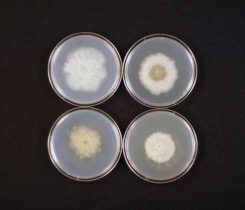The future of resistance management
Resistance management, arguably, has never been a more important issue for superintendents in every region of the United States. After all, fewer and fewer new fungicide chemistries are now being produced for the turfgrass market, and this trend is expected to continue for years.
Because there simply aren’t many rotational partners to choose from, existing chemistries are facing higher resistance pressure. As a result, there also are potential restrictions on current resistance management products, leaving superintendents with no choice but to focus on developing new resistance management strategies for the future.
To help superintendents prepare for the coming age of resistance management, Paul Koch, Ph.D., assistant professor in the plant pathology department at the University of Wisconsin-Madison, presented a GCSAA webinar. The webinar focused on the future of resistance management and discussed some surprising aspects of such management, as well as tactics superintendents should consider implementing for long-term success. Here’s a rundown on the webinar’s focus.
Overcoming misconceptions and impending obstacles
Despite persisting in the environment for similar amounts of time, fungicides tend to provide different lengths of disease control. Superintendents need to understand why this occurs. If they don’t, they won’t know the impact of fungicide resistance on disease control.
“For instance, the product Heritage provides 28 days of brown patch control, while Tourney provides 14 days,” Koch explains. “However, both products are mostly undetectable in the plant after seven to 10 days, suggesting the length of efficacy is based on a product’s impact on the fungal population rather than its persistence.”
With this in mind, superintendents shouldn’t focus on the 7-day to 10-day phase in which fungicides are no longer present in the environment. Instead, they should emphasize the importance of fungi’s recovery periods — the true evidence of efficacy length.
“Always remember that a product like Emerald, which has a recommended reapplication interval of approximately 28 days, may stunt growth of a fungus to the point that it takes 28 days for it to recover and begin to cause disease again,” Koch says. “So there is no need to spray the fungus again until it’s active, or else it won’t absorb the fungicide anyway.”
It’s also important to understand the influence of fungi’s hyphae. All fungicides are absorbed by the hyphae (growing tips), which can extend upward of 40 micrometers each minute. Although fungicides kill most cells, more cells still begin to grow immediately after the fungicides have dissipated from the hyphae. Superintendents must wait until this growth is occurring again, thereby ensuring the process of killing hyphae cells can successfully continue. In doing so, they’ll be able to maximize efficacy length and considerably improve the quality of their turfgrass.
Aside from the possible misconception of efficacy length, two types of fungicide resistance potentially lead to long-term fungus issues: receptor-mediated and non-receptor-mediated resistance. Receptor-mediated resistance — in which a mutation in a fungicide’s binding site leads to inactivity — has been studied for a long time, leading to a relatively vast understanding of the ways in which it varies from one class of fungicides to the next.
“For example, quinone outside inhibitors (QoI) have a fairly high risk of resistance development, as only one mutation can lead to total resistance, while benzimidazoles have an even higher risk of resistance development,” Koch says. “On the other hand, the risk is much lower for demethylation inhibitors (DMI), as multiple genes are involved in resistance, which requires multiple mutations to accumulate over time. This in turn leads to a gradual shift in the overall fungal population toward organisms that are more resistant.”
Non-receptor-mediated resistance, however, has been studied for only the past few years. Nonetheless, this newer area of resistance study already is revealing significant information about fungicide efficacy. First, because of this resistance, fungicides can be escorted out of cells, so to speak, by “ABC transporter” molecules. Afterward, the fungicides are completely broken down (by molecules known as CYP450 monooxygenases) before they ever reach hyphae cells.
“All fungal cells have these ‘transporter’ metabolizing molecules, but the cells involved with non-receptor-mediated resistance have a much higher number,” Koch stresses. “So superintendents must react accordingly and focus on a variety of resistance management strategies.”
The five strategies
Although it’s difficult to stop receptor-mediated and non-receptor-mediated resistance completely, both types of resistance can be slowed considerably, particularly through the following resistance management practices.
Maximize turf health. Superintendents must have accurate mowing heights, optimal drainage mechanisms, healthy soil and facilities they can use long-term (and preferably even expand upon) for equipment and fungicide storage. Without these necessities, superintendents won’t be able to maintain healthy turfgrass. The bottom line: The healthier turf is, the less likely superintendents will be reliant on chemicals.
Choose the right product. Location is, of course, the most significant factor influencing fungicide selection. For example, dollar spot is most prevalent in the Midwest, while anthracnose is more dominant in the Northeast and Northwest. But as superintendents determine which products are most effective for their courses, they should also consider seeking advice from local university Extension specialists, industry representatives like distributors and sales reps, and fellow superintendents, especially as they consider purchasing new products.
Spray only when necessary. “Remember, a fungus will only absorb a fungicide when it’s active — when the fungal tip is growing,” Koch states. “The more often fungicides are applied, the higher the level of resistance. Only spray when the fungicide is no longer effective and the fungus has begun to grow again.”
Optimize the fungicide application. To ensure that fungicide efficacy endures as long as possible, it’s important to confirm that water volume levels are accurate and fungicide coverage is precise. As Koch stresses, if fungicide coverage is optimal, the control of fungicide resistance will be optimal as well.
Rotate/tank-mix products. “If superintendents rotate chemistries or tank mix multiple chemistries, individual fungal strains will likely be less resistant to multiple fungicide classes,” he says. “Rotating and tank mixing also ensures that no single resistant strain of the fungus will dominate the rest of the population.”
Looking ahead
As superintendents prepare to implement each of these resistance management strategies, Koch believes that technology — including GPS equipment and portable weather sensors — will drastically change the way they spray, ensuring they treat only areas of their courses experiencing high disease pressure. These spray changes will not only improve superintendents’ bottom lines, they’ll also help them minimize resistance consistently and for the long term.
“In particular, GPS technology will fine tune the parts of the courses that need to be sprayed, which reducesoverlapping sprays as well as the amount of product that’s released into the rough and other areas where it’s not needed,” he states. “Small, portable weather sensors, meanwhile, will allow for site-specific spraying as well.”
Simply put, the value of spraying the correct amount of preventative fungicide at the exact location it’s required can’t be underestimated. Although this means of cost savings and resistance management is today overlooked by some superintendents, Koch believes that will soon be the case no longer.
“Right now, the common practice is to spray the entire golf course,” he says. “But that’s about to change as technology continues to advance and enter the market at a steady pace.”
Photos: Paul Koch












